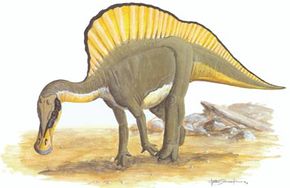OURANOSAURUS (oo-RAN-oh-SORE-us)
Period: Early Cretaceous
Advertisement
Order, Suborder, and Family: Ornithischia, Ornithopoda, Iguanodontidae
Location: Africa (Niger)
Length: 23 feet (7 meters)
Ouranosaurus is one of the most puzzling large ornithopods of the Cretaceous. Discovered in 1966 in Niger, Africa, this new dinosaur was first named and studied in 1976. Its name means "brave reptile."
In many ways, Ouranosaurus looked about the same as other ornithopods. It was a large and powerfully built animal that mostly walked on its stocky back legs. The front legs were smaller than the back legs but were strongly built. The toes of the hands and feet had blunt hooves. Ouranosaurus may have used all four legs to walk slowly or to rest. It probably used only its back legs for rapid running. Like its relatives Iguanodon and Camptosaurus, its hand had a sharp thumb spike that would have been a dangerous weapon against any predators.
What is puzzling about Ouranosaurus is its very different head and skeleton. Its head was very large and its jaws were long. There was room for massive jaw muscles for chewing. The front of the snout was flat and broad and was probably covered by a horny beak. The nostrils were somewhat back from what is seen in Iguanodon and Muttaburrasaurus. Ouranosaurus looked a little like the hadrosaurid Edmontosaurus from the Late Cretaceous in Canada.
Above the eyes along the top of the snout was a pair of low, broad bumps. Only Ouranosaurus had these, and they may have been used for display, much like the small horns of some antelopes. A male Ouranosaurus might have used the bumps during head-butting contests, perhaps to defend his territory, or the bumps may have been important for its own family group or species to recognize each other.
Ouranosaurus had many features in common with Iguanodon. The jaws of Ouranosaurus had many teeth, which were similar to the teeth of Iguanodon. Ouranosaurus was probably the main plant-eater of its time in what is now western Africa. Ouranosaurus used an interesting, somewhat complex skull motion of the upper jaws. It produced sideways movement during chewing. This way of chewing, also found in hypsilophodontids and hadrosaurids, may have made these animals the most successful plant-eaters of the Mesozoic Era.
Perhaps the most puzzling thing about Ouranosaurus is the large sail on its back. The sail was formed by the long spines on the vertebrae (bones of the spine). How this sail functioned has been somewhat perplexing. Since Ouranosaurus lived in a somewhat warm and dry climate, the sail may have helped it live in this harsh habitat. The skin around the sail may have had many blood vessels that would have released heat on hot days and captured heat on colder days.
Several nearly complete skeletons of Ouranosaurus have been found in Niger and surrounding areas in Africa. Ouranosaurus is closely related to Iguanodon and the more primitive hadrosaurid Telmatosaurus.
Advertisement
